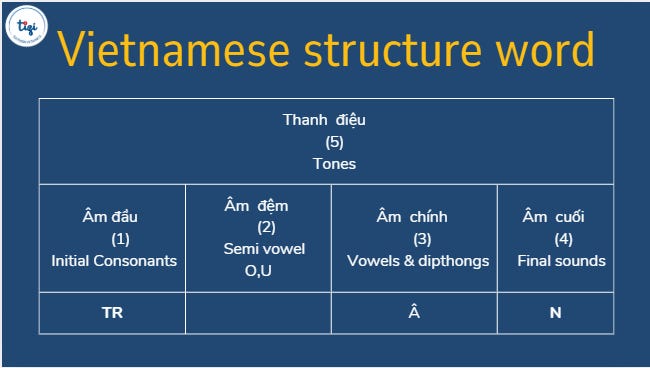Crack the Code, Speak with Confidence
Every beginner can come across with Vietnamese structure at the beginning lesson. However, do you really recognize the importance of it?
Pronunciation is one of the hardest parts in learning Vietnamese. But the truth is: by really mastering the Vietnamese syllable structure, it can be a useful “magic companion” to help you overcome the first obstacles much more easily.

The Vietnamese Syllable Structure
In Vietnamese linguistics, a syllable (âm tiết) is not random. It is built from five possible components:
- Âm đầu (initial consonant)
- Âm đệm (u/o] glide before the main vowel)
- Âm chính (nucleus vowel)
- Âm cuối (final consonant or semi-vowel)
- Thanh điệu (tone, covers the entire syllable)
Not every syllable has all five parts. Some may lack an initial consonant (ăn), some may not have a final consonant (ba), some may skip the the second part (hôn)…But in principle, the structure can be represented as:

Take the word “Trân”:
- Âm đầu: tr
- Âm đệm: _ (absent)
- Âm chính: â
- Âm cuối: n
- Thanh điệu: ngang
Understanding the Vietnamese syllable structure is not just a matter of theory. It brings at least three direct benefits to every learner:
1. Pronounce Correctly
You can think of this structure as a frame. Every Vietnamese syllable fits neatly into this frame, no matter how simple or complex it is. With this frame, you can split any syllable into clear components (disassemble it), or build it back again (assemble it). So, instead of copying a sound by ear and hoping for the best, you use the frame to break down a word into its building blocks and then put them together again step by step. This makes pronunciation logical repeatable, and easy to check.
Example:
- hoàng → h | o | a | ng + huyền → (hoàng)
- thuốc → th | u | ô | c + sắc → (thuốc)
- Trăng → tr | (none) | ă | ng + ngang → (trăng)
- Biển → b | i | ê | n + hỏi → (biển)
By that way of analyzing, you know exactly what to produce. Or on the other hand, once you know this skeleton, you can pronounce any word with much greater accuracy.
More over, because each syllable carries meaning on its own, pronouncing it correctly is not just good practice — it is essential for being understood.
2. Prevent Spelling Mistakes
Learners often confuse “d/gi/r” or “s/x”, or even invent spellings based on what they think they hear. This happens because they don’t know which combinations are actually possible in Vietnamese.
When you master syllable structure, you automatically avoid such errors. For example, Vietnamese does not allow tl at the beginning of a syllable, or bp at the end. By knowing these rules, you won’t waste time writing or pronouncing something that doesn’t exist.
This also means your reading and writing skills improve faster: spelling is no longer a matter of memorization alone, but of logic and structure.
3. Land the Tones Exactly
Tone is not an optional feature in Vietnamese — it is an inseparable part of the syllable. If you already recognize the “body” of the syllable, placing the “soul” (the tone) becomes a natural step, not an afterthought.
Take the set ma, má, mà, mả, mã, mạ. The initial and rhyme are the same (m + a), but the tone changes the meaning completely. Without a good sense of where the syllable begins and ends, many learners slide tones across multiple syllables or attach them too late.
By mastering syllable structure, you learn to “land” each tone directly on its target — making your speech clear, natural, and authentically Vietnamese.
Conclusion
The Vietnamese syllable is simple in form but profound in function. To learn Vietnamese without understanding its structure is like trying to play music without knowing rhythm. Once you grasp this foundation, every step — pronunciation, spelling, and tone — becomes easier and more logical.
That is why mastering the syllable structure is not only useful, but absolutely essential for anyone who wants to speak Vietnamese well.
